*Editor's note: K-VIBE introduces travel journals by alumni of Yonhap News Agency Travel Academy, provided in Korean and English. The original Korean article precedes the English translation.
*편집자 주: K-VIBE는 연합뉴스 <여행자학교> 수료생들의 여행기를 한국어와 영어로 소개합니다. 한국어 원문을 먼저 게재한 뒤 외국 독자들을 위해 영어 번역본도 함께 싣습니다.
4일 차> ㆍ새벽 푼힐 전망대 일출: 고레파니(2,800m) ㅡ 푼힐(3,210m) ㅡ 고레파니
ㆍ조식 후 6 시간 트레킹: 고레파니-데우랄리-반탄티(3,180m)-타다파니(2,640m)
히말라야에서 가장 아름다운 산을 만나던 날.
신훈 (여행자학교 5기)
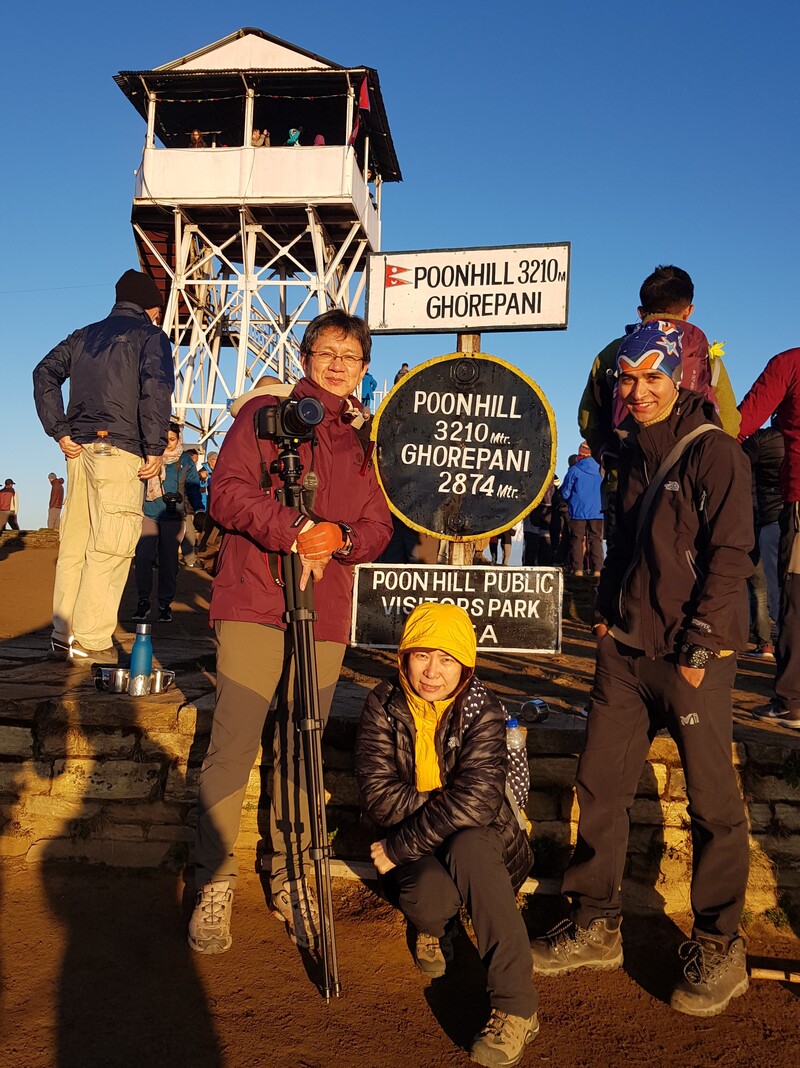 |
16일 걸리면 되는 길을 15일 만에 가려다 사고가 난다.
네팔 도착 후 5일 째 새벽. 드디어 우리는 네팔의 산을 만나기 위해 중부 히말라야에서 아름답기로 손꼽히는 푼힐전망대에 오르고 있었다. 일출을 볼 예정이었다.
새벽 등정은 힘겨웠다. 어둠 속에서 많은 사람들과 걷다 보니 뒤처지면 안 될 것 같았다. 우리 발걸음이 조급해 질 때마다 가이드 사무엘은 몇 번이고 서두르지 말라고 한다. 빨리 걸어봤자, 조금 더 빨리 도착할 뿐이라는 것이다.
“한국 사람들은 계획을 아주 타이트하게 잡아요. 이날에는 여기까지, 이날은 여기까지 가야 한다고 정하고 오지요. 산에서는 그렇게 안 돼요. 일기나 그 날의 상황에 따라 조정을 하지 않으면 사고가 나요. 결국 그렇게 가더라도 15일 째 가야하는 길을 16일 째 도착하면 돼요.”
사무엘은 ‘걷는다는 것’에 대해 여러 번 얘기해 주었다. 햇수로야 내가 그의 두 배도 더 걸었겠지만, 히말라야에서는 그가 선생님이었다. 나는 ‘걷는’ 것을 다시 배우고 있었다.
걱정한대로 문제가 발생했다. 일행 중 한 명이 고산증을 호소했다. 어지럽고 메스꺼워 했다. 전날 가이드에게 너무 천천히 걷는다고, 너무 쉬워 히말라야 트레킹 같지 않다고 불만을 표한 사람이었다. 할 수 없이 사무엘이 그 트렉커를 도와 천천히 오기로 했고, 나는 단체와 함께 먼저 가기로 했다.
올라가는 길은 어두워서 주변이 보이지 않았다. 3000m를 넘어가자 호흡도 약간 불편해지는 느낌이 들었다. 고산병에 대한 두려움이 밀려왔다. 머리를 숙이고 걸음에 집중했다. 낯선 경험. 어둠 속에서 말 한마디 하지 않고 같은 속도로 걷고 있는 수백 명의 사람들. 발자국 소리와 흰 입김들만이 자욱했다.
갑자기 ‘무엇을 보러 가는 것일까.’라는 생각들이 들었다.‘다들 무슨 생각을 하고 있을까.’ 마치 참배를 가는듯한 엄숙함. 엄숙함이 긴장을 가져오고 긴장한 만큼 더욱 걸음에 집중하며 걸었다.
롯지(숙소)에서 매표소까지는 약 40분 정도가 걸렸다. 여전히 어두웠지만 매표소에는 꽤 많은 사람들이 모여 있었다. 표를 사는 사이 잠시 휴식을 취했다. 다시 출발. 이번에는 걸음 수를 세며 걸었다. 847 걸음. 마침내 최종 목적지 3,210m 푼힐 전망대 도착.
아, 거기 내가 그렇게 고대하던 히말라야가 구름처럼 떠 있었다.
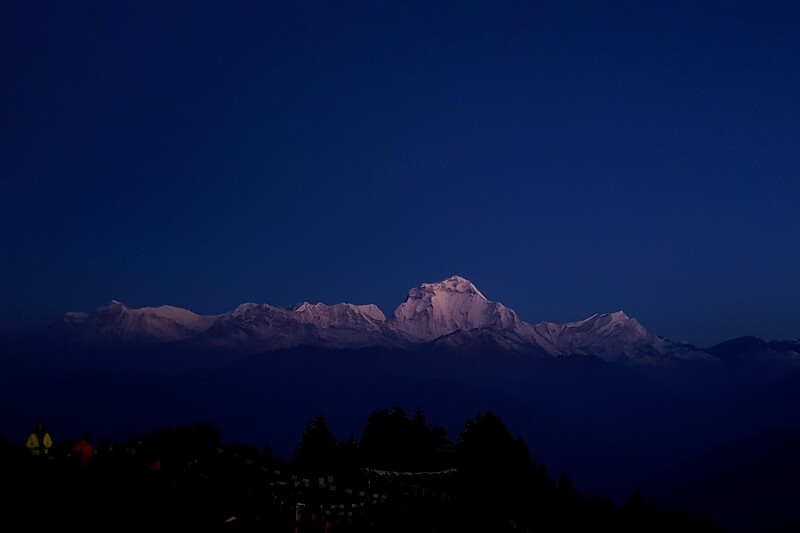 |
| ▲ 일출 직전 다울라기리. 눈에 보이는 밝기 그대로 찍은 사진. |
히말라야 최고의 전망대 다웠다. 중부지역 히말라야 고봉들이 180도의 화면 가득 파노라마로 펼쳐졌다.
며칠 전 한국인 원정대가 참사를 당한 다울라기리는 커다란 제단처럼 정면에 위치하고 있었다. 안나푸르나 사우스와 히운출리는 우측에 나란히 서있었다. 산을 오르는 내내 일부만 보여주던 산들이 이번에는 가린 것 하나 없이 웅장한 전신을 보여주었다. 신화 속 수많은 신들처럼 도열한 모습.“자, 이만하면 만족해?” 며칠 동안 툴툴거리고, 궁금해 하며 오른 나를 굽어보는 산들.
눈의 집, 히말라야.
'히마(himá)'는 산스크리스트어로 ‘눈’을 '알라야(ā-laya)는 '거처'를 의미한다. 즉 '히말라야(Himā-laya)'는 '눈의 거처', '눈이 사는 곳'이라는 뜻이 되는데, 내 눈 앞에 펼쳐진 정경이 딱 그랬다. 눈 덮인 산이 살고 있었다.
해가 떠오르는 정도에 맞춰 산의 모습을 담았다. 히말라야 여행을 준비하는 동안 꼭 찍고 싶었던 풍경들.
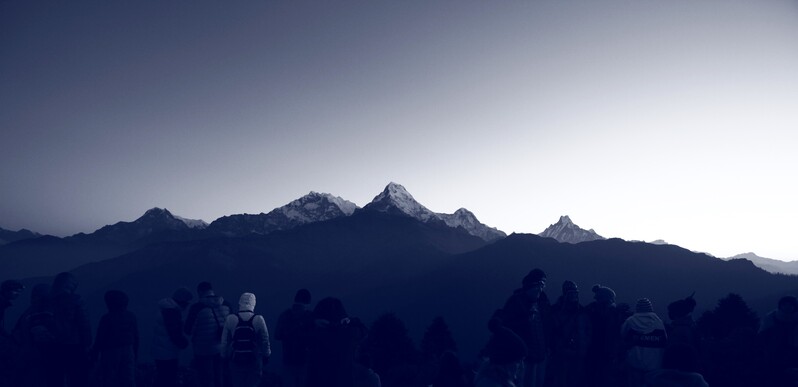 |
| ▲ 일출 직전의 안나푸르나 사우스. |
눈에 불이 붙다.
일출이 시작되면 만년설로 덥힌 산 정상에 촛불이 켜진다. 눈에 붙인 불. 거대한 산을 싸고 있던 어두운 포장이 녹아내린다. 불길이 점점 넓어질수록 경험한 적 없는 모습들이 드러난다. 비현실적인 크기에 더해진 풍경은 아름다움을 넘어 경이롭다. 압도적이고 신성이 느껴진다. 경탄하게 되는 순간만큼 셔터를 누른다.
 |
| ▲ 일출 시작. 봉우리 끝이 붉게 물든 정도를 보면 일출 정도를 알 수 있다. |
 |
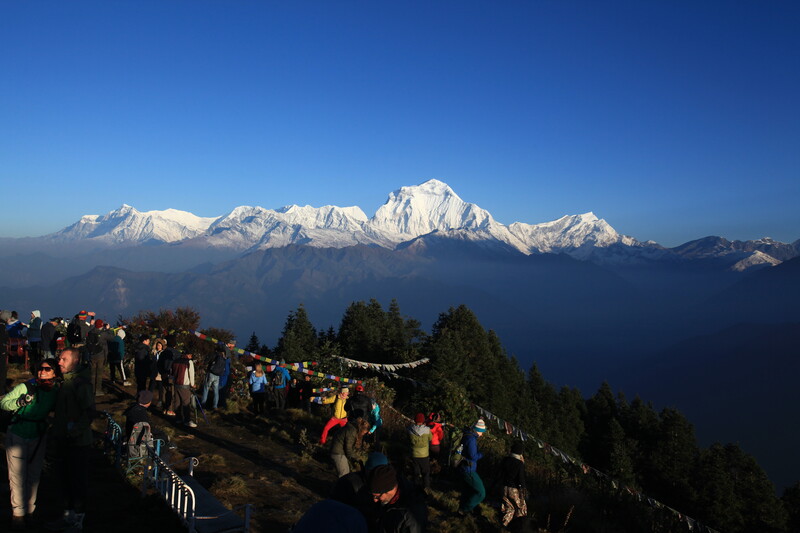 |
| ▲일출이 끝나자 완전히 드러난 다울라기리 |
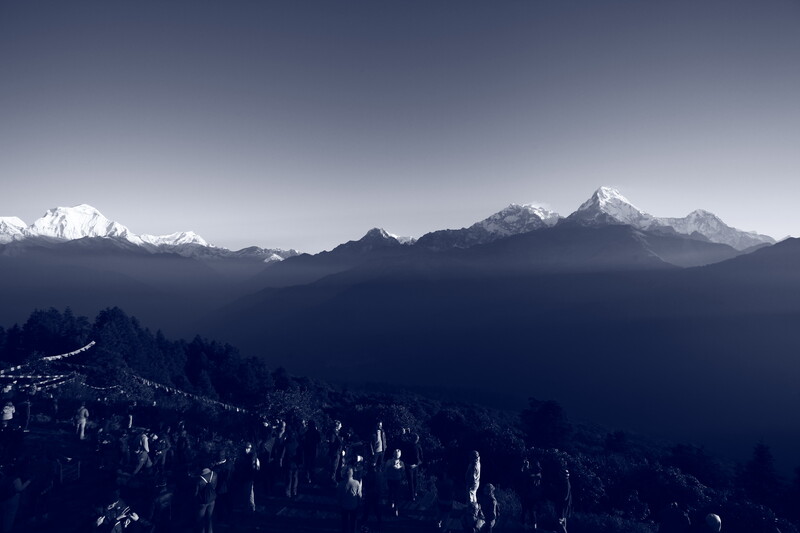 |
| ▲다울라기리(좌)와 안나푸르나 사우스(우)를 같이 담아 보았다. |
안나푸르나 사우스 측 산군(山群)의 일출을 찍어본다. 일출이 진행될수록 먼 곳에서 온 경배자들의 모습이 드러난다.
 |
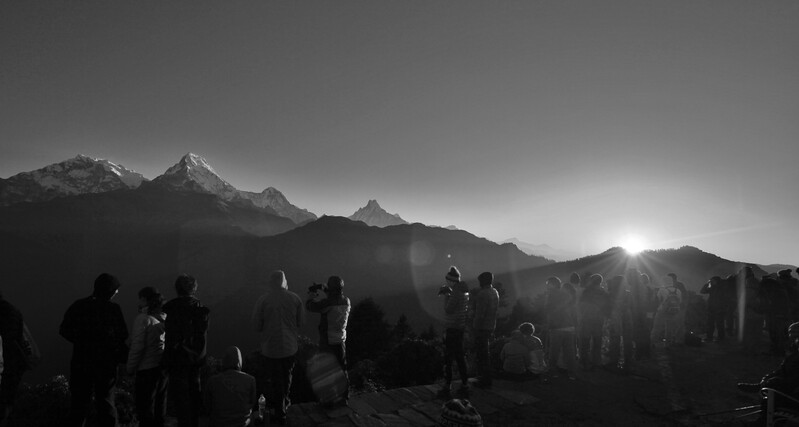 |
완전히 해가 뜨자 푼힐 전망대는 그야말로 관광지였다. 모두들 감탄하며 아름다운 모습을 담기 위해 분주한 모습들. 그들이 감탄하니 나도 더 멋지게 느껴지기도 했다.
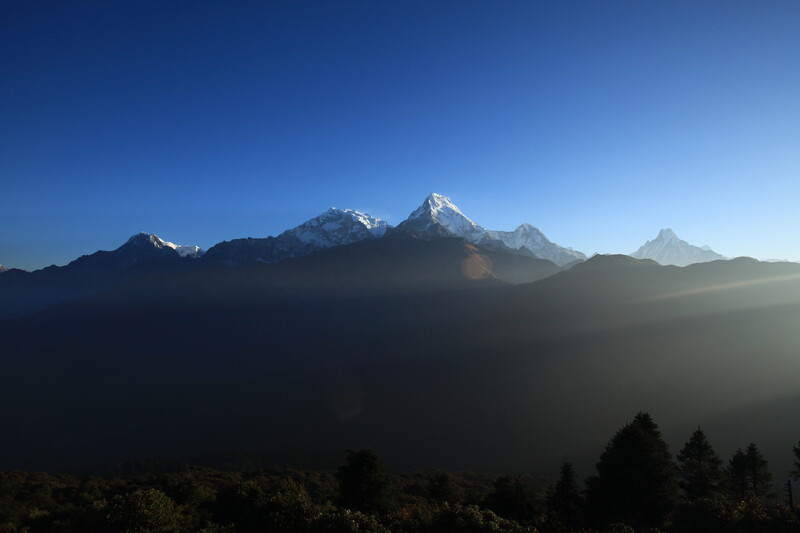 |
| ▲해가 완전히 뜬 후의 안나푸르나 사우스. |
히말라야에 오기 전 푼힐 전망대에서 찍은 많은 사진을 보면서 기대를 많이 했었다. 기대한대로 전망대에서는 멋진 풍경을 찍을 수 있었다.
내려 올 때 들을 수 있었던 산들의 이야기들.
그러나 또 다른 히말라야를 만난 것은 하산 길이었다. 전혀 상상하지 못했다. 나는 그것이 히말라야가, 기대하고 준비했던 한 추종자를 위해 준비한 선물이었다고 생각한다. 단지 특별한 의미를 전달하기 위해선 의외의 시간과 장소가 필요했었던 것 같다.
하산 길에 발견한 아름다운 히말라야
일출이 끝났다. 산 정상을 넘는 구름처럼, 거대한 관광객 무리는 빠르게 사라졌다. 사진을 찍고 조금 감상하다보니 한 줌의 사람만 남아 있었다. 거대한 사람의 무리가 빠져나간 텅 빈 전망대는 외로움마저 느껴졌다.
하산 길도 오를 때와 전혀 달랐다. 한적한 하산 길에는 관광객도, 감탄도 없었다. 올라갈 때 맞춰야 했던 무리의 속도를 벗어나 나만의 속도로 내려왔다. 주변을 둘러볼 여유도 있었고, 멈춰 서서 원하는 만큼 즐길 수 있었다.
꼭 정상에서만 가장 아름다운 경치를 볼 수 있을까.
사람이 있는 산과 없는 산은 느낌이 다르다. 사진에서는 거대한 풍경에 작은 사람, 하나의 점이 단조로움을 지우고 전체를 살려줄 때가 있다. 그러나 그날은 달랐다. 사람이 사라지니 산만이 온전히 내 시야의 주인이 되었다. 산에 훨씬 몰입되고, 그만큼 느낌과 감정도 더 생생해졌다.
오르막의 시간, 내리막의 시간.
산 정상에서 관광객에 둘러싸여 보는 산은 마치 공연장에 선 빅 스타를 보는 듯 했다. 반면에 하산 길에 혼자 마주 하게 된 산은 평상복으로 갈아입은 스타와 캐주얼한 식사를 사이에 두고 단 둘이 앉게 된 것 같다고 할까. 그 스타의 숨소리와 눈길을 오롯이 갖게 된 듯, 나와 눈 맞춤 하는 산. 나는 산을 세세히 살필 수 있었고, 비로소 산을 느끼기 시작했다.
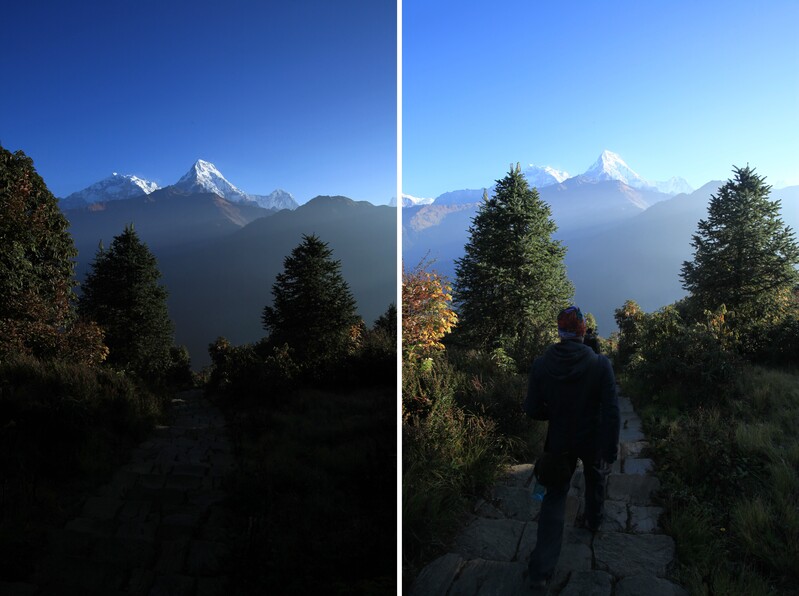 |
| ▲두 개 사진의 차이가 느껴지는가? 사람이 있고 없는 산의 모습은 다르다. |
그 때 부터는 내가 느끼는 산을 찍으면서 천천히 내려왔다. 뭐랄까, 정상보다 조금 덜 웅장하고 극적인 앵글은 아니었지만 느낌은 좋았다. 지금 보아도 그 느낌이 있다. 조용히 혼자 바라보는 산들은 담을 때마다 감추어졌던 모습을 보여주었다. 히말라야가 좀 더 내 것이 되고 있었다.
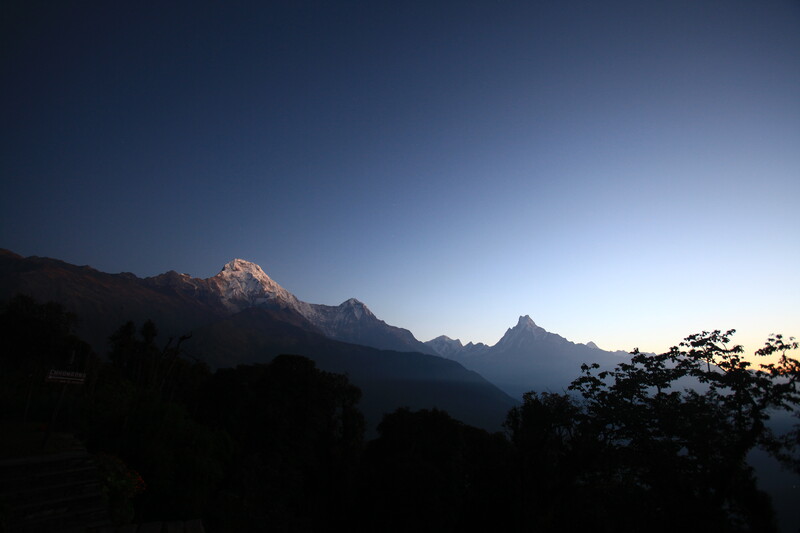 |
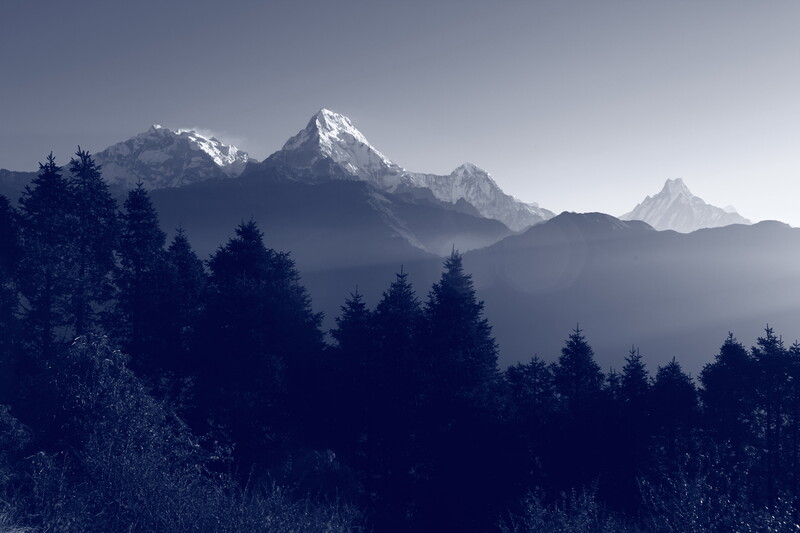 |
 |
 |
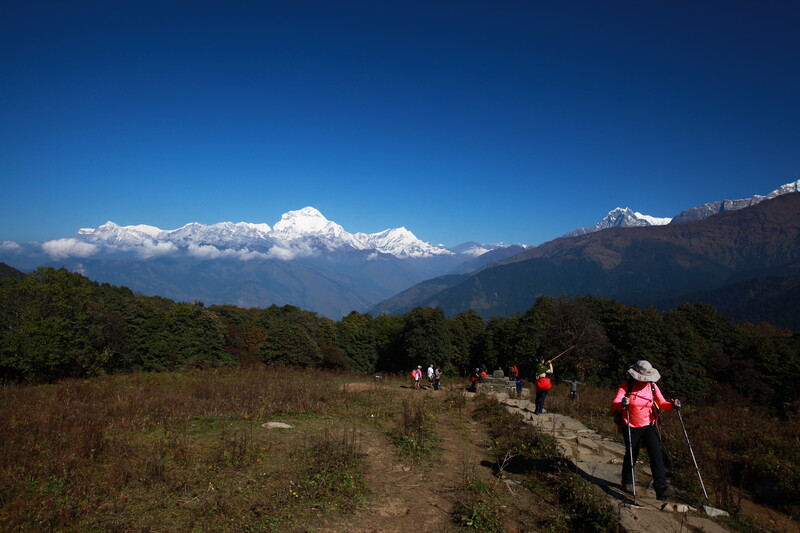 |
노(老)시인 말이 떠올랐다.
내려갈 때 보았네,
올라갈 때 보지 못한
그 꽃.
아름다움을 발견할 수 있는 기회는 너무도 많았다.
푼힐 전망대 풍경은 아름다웠다. 명성이 아깝지 않았다. 내게 있어 푼힐전망대는 이번 여행의 피크였다. 내 여행의 피크. 그 정상에서의 풍경만 꿈꾸며, 준비를 했다. 나머지는 그 절정을 맛보기 위해 감수해야 하는 여정이라고 생각했다.
그러나 실제 나의 여행은 어떠했는가? 매순간 풍요롭고 신비롭고 아름답게 펼쳐지고 있었다. 정상에서의 30분으로 모든 것을 희생시키기에 나머지 시간은 너무 길었다.
아름다움은 정상에만 있지 않았다. 오르는 길에도, 하산 길에도 있었다. 샛길에도 있었다. 이를 보려면 시끌벅적한 들뜸에서 벗어나야 했다. 내가 원하는 아름다움에 대한 집착은 큰 장애였다. 타인의 추종에서 벗어나고 마음을 열어야 했다. 그러면 매번 신기하게도 그 사이로 빛과 바람이 스며들었다.
조금만 마음의 문을 열고 걸으면 그곳으로 바람과 햇볕이 들어온다.
정상에 가는 것만 아니라, 오르고 내려오는 전 과정이 여행이라는 것. 나는 내 여행의 전 과정에 열려 있어야 한다는 것, 가끔 혼자가 되는 것도 두려워하거나 꺼리지 말아야 할 것이고. 하산 길, 히말라야가 귀띔 해준 얘기.
 |
| ▲하산 길에 만난 마차푸차레. “물고기 꼬리”라는 뜻이다. 6천 미터 급이면서도, 네팔인들이 가장 신성시 하는 민족의 靈山. 일반 산악인 등정은 금지다. |
[사진= 신훈 제공]
Encountering the crown jewel of Himalayan mountains
By Shin Hoon (Alumnus of Travel Academy season 5)
Day 4: Dawn at Poon Hill viewpoint: Ghorepani (2,800 m) → Poon Hill (3,210 m) → Ghorepani
6 hour trek after breakfast: Ghorepani → Deurali → Banthanti (3,180 m) → Tadapani (2,640 m)
 |
You are looking for accidents when you insist on finishing a 16-day journey in 15 days.
It was the fifth day since arriving in Nepal, early in the morning. Finally, we were ascending the renowned Poon Hill viewpoint in the central Himalayas of Nepal, famous for its breathtaking beauty. We were scheduled to witness the sunrise.
The early ascent was challenging. Walking in the darkness among many people, it felt like we shouldn't lag behind. Whenever our pace seemed hurried, our guide Samuel advised us not to rush. He said that hurrying wouldn't make us arrive significantly earlier; it was crucial to adjust plans according to the weather and circumstances.
"Koreans tend to plan very tightly. They decide to go up to a certain point on a particular day. That's not how it works in the mountains. If you don't adjust according to the diary or the day's situation, accidents happen. Eventually, even if you go that way, it's okay to arrive on the 16th day instead of the 15th," Samuel said.
Samuel talked about “walking” several times. While I might have walked twice as much as him in terms of steps, in the Himalayas, he was the teacher. I was learning to “walk” again.
As feared, a problem arose. One of our group members complained of altitude sickness. They felt dizzy and nauseous. The previous day, they had expressed dissatisfaction to the guide about walking too slowly, saying that the Himalayan trekking didn't feel challenging enough. Samuel had to assist the trekker slowly, and I decided to continue ahead with the group.
The ascent was dark, and surroundings were invisible. As we passed 3,000 meters, breathing became slightly uncomfortable, and fears of altitude sickness surged. I lowered my head and focused on my steps. It was a strange experience -- walking in the darkness without a word, surrounded by hundreds of people moving at the same pace. Only the sound of footsteps and white breaths filled the air.
Suddenly, thoughts like “What are we going to see” crossed my mind. “What are the others thinking?” It felt like going on a pilgrimage, with solemnity bringing tension, and with tension, more focus on walking.
It took about 40 minutes from the lodge to the ticket booth. It was still dark, but quite a few people had gathered at the booth. We took a brief rest while buying tickets. Then we set off again, this time counting our steps. Okay, 847 steps. We finally reached our destination: Poon Hill viewpoint at 3,210 meters.
Ah, there it was, the Himalayas I had longed for, floating like clouds.
 |
| ▲ Just before sunrise, Deurali. A photo taken with the brightness as it appears to the eyes. |
It was the ultimate viewpoint in the Himalayas. The towering peaks of the central Himalayas spread out in a 180-degree panorama.
A few days ago, a Korean expedition met a tragedy on Deurali, which stood like a grand altar right in front of us. Annapurna and South and Hiunchuli stood side by side on the right. The mountains, which had only partially revealed themselves during the climb, now displayed their majestic figures without any hindrance. They seemed arranged like countless gods in a myth. "Are you satisfied now?" The mountains, which I had climbed with complaints and curiosity for days, now looked down at me.
The home of snow, the Himalayas.
"Hima" means 'snow' in Sanskrit, and "alaya" means "abode." So "Himalaya" means "the abode of snow," and that's exactly what unfolded before my eyes. The snow-covered mountains were alive.
I captured the mountains according to the level of sunrise, the landscapes I had eagerly wanted to capture while preparing for the Himalayan journey.
 |
| ▲ Just before sunrise, Annapurna South. |
Burning snow
As the sunrise begins, candles are lit on the snow-covered peaks. Flames attached to the eyes. The dark veil that covered the massive mountains melts away. As the flames spread wider, unseen scenes unfold. The landscape, enhanced by its surreal scale, transcends beauty to become awe-inspiring. It feels overwhelming and sacred. I press the shutter as I am struck with admiration.
 |
| ▲ Sunrise begins. The reddened peaks indicate the degree of sunrise. |
 |
 |
| ▲ As the sunrise ends, Deurali is fully revealed. |
 |
| ▲I captured Deurali (left) and Annapurna South (right) together. |
I try to capture the sunrise on the side mountains of Annapurna South. As the sunrise progresses, the figures of worshippers from afar become apparent.
 |
 |
When the sun rises completely, Poon Hill viewpoint becomes a tourist spot. Everyone is busy capturing the beautiful scenery. Their admiration made me feel even more wonderful.
 |
| ▲ Annapurna South after the sun has risen completely. |
Before coming to the Himalayas, I had high expectations as I looked at many photos taken from Poon Hill viewpoint. As expected, I was able to capture stunning landscapes from the viewpoint.
Descending
and the stories of the mountains I could hear
But encountering another Himalayas was on the descent. I never imagined it. I think it was a gift prepared for a follower of the Himalayas, delivering a special meaning required an unexpected time and place.
The
beautiful Himalayas discovered on the descent
The sunrise had ended. Like clouds passing over the summit, the massive crowd of tourists disappeared quickly. After taking some photos and admiring the view, only a handful of people remained. The empty viewpoint, emptied of the massive crowd, felt lonely.
The descent was completely different from the ascent. There were no tourists or admiration on the quiet descent path. I descended at my own pace, free from the pace of the crowds I had to keep up with on the ascent. There was leisure to look around, to stop and enjoy as much as I wanted.
Is
the most beautiful view only seen from the summit?
Mountains with people and without people feel different. In photographs, a small person, a single dot, sometimes erases monotony from the vast landscape and brings it to life. But that day was different. With the people gone, the mountains became the sole owners of my sight. I became much more immersed in the mountains, and consequently, my feelings and emotions became more vivid.
The
time of ascent, the time of descent.
Looking at the mountains surrounded by tourists from the summit felt like watching a big star on stage. On the other hand, encountering the mountains alone on the descent felt like sitting with a star dressed casually and having a casual meal in between. Like having the mountains all to myself, where I could examine them closely and finally begin to feel them.
 |
| ▲ Can you feel the difference between these two photos? The appearance of the mountains with and without people is different. |
From then on, I slowly descended while capturing the mountains I felt. It wasn't as grand or dramatic as the summit, but it felt good. Even now, I can still feel it. Quietly gazing at the mountains alone revealed aspects that had been hidden each time I captured them. The Himalayas were becoming more mine.
 |
 |
 |
 |
 |
A saying from an old poet came to mind.
"Saw it when I descended,
Had missed it when I ascended,
O that flower.”
There
were so many opportunities to discover beauty.
The landscape from Poon Hill was beautiful. It lived up to its reputation. For me, Poon Hill was the peak of this journey. The peak of my journey. I had dreamed and prepared for the scenery from that summit. I thought the rest of the journey was just something to endure to taste that pinnacle.
But what was my journey really like? Every moment was rich, mysterious, and beautiful. Sacrificing everything for just 30 minutes at the summit seemed too long for the remaining time.
Beauty wasn't only at the summit. It was on the way up, on the way down, and in the side paths. To see it, I had to break away from the hustle and bustle. My obsession with the beauty I desired was a major obstacle. I had to break away from others' followers and open my heart. Then, strangely, light and breeze always found their way in.
If
you just open the door of your heart a little and walk, wind and sunlight come
in.
It's not just about reaching the summit; the entire process of climbing up and coming down is the journey. I must be open to the whole process of my journey, not afraid or reluctant to be alone sometimes. The stories told by the descent, the Himalayas.
 |
| ▲ The Marpha (마차푸차레) encountered on the descent. It means "fish tail" in Nepali. It's the most sacred mountain for Nepalis, even though it's 6,000 meters high. Ordinary mountaineering is prohibited. |
[Photo courtesy of Shin Hoon]
(C) Yonhap News Agency. All Rights Reserved


































